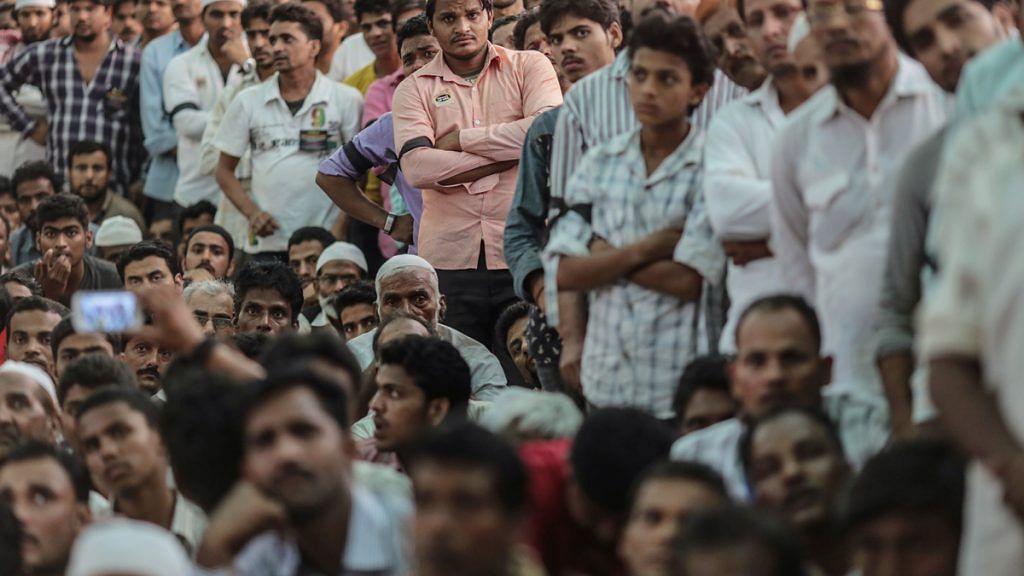Economic growth, migration & democracy are limiting the unrest that might have otherwise occurred in India.
How many jobs India created or extinguished over the past few years has become a controversial question. The new data that have emerged look bad: CMIE’s survey estimates 11 million (or 1.1 crore) jobs were lost in 2018, bringing the unemployment rate to 7.38 per cent, while a leaked NSSO report put that figure at 6.1 per cent, the highest in more than four decades. The Narendra Modi government’s refusal to release the unflattering numbers muddies the waters even more, causing its partisans to deny that there is a problem at all and the rest to fear that the actual reality is far worse.
Soon after the Centre for Monitoring Indian Economy (CMIE) figures came out late last year, a hard-nosed analyst friend argued that 11 million jobs lost doesn’t pass the smell test. If that many jobs were lost, he argued, wouldn’t there be protests on our streets? Since then, I got a similar reaction from many people, not all of them supporters of the Modi government. Even Arun Jaitley, Union minister, said as much: “If the economy is growing at 12 per cent nominal growth for the last five years, it would be an economic absurdity to say that such a large economic growth, the highest in the world, doesn’t lead to the creation of jobs… If no job creation takes place then there is social unrest. This has been a peace period where no major social agitation has been witnessed in the last five years.”
So where is the social unrest?
Also read: Jobs, not josh: Modi government’s interim budget missed the elephant in the room
First, over the past few years we have seen a number of activities — ranging from village vigilantes, to political gangs to mass agitations by Jats, Patidars, Kapus, Marathas, farmers and so on — that involved large numbers of people of working age. Not all of these involved direct demand for jobs, although some of them indirectly did so through the demand for job reservations. What is clear though is that there are a large number of people who can afford to spend days engaged in the physically demanding task of holding protests. Such people are clearly un- or under-employed.
Whether or not these protests increased in numbers and frequency after 2014 is a loaded political question, which will receive partisan responses. The jobs debate has become political in an election year, because this kind of issue ought to be thrashed out — this is a metaphor — openly in public. Yet whatever the political persuasion, no reasonable person can argue that social unrest involving tens of thousands of people of working age is something we can afford to ignore; or that such protests would be less intense and less frequent if many of those protesters had jobs that gave them good pay, satisfaction and status.
So yes, there is social unrest in the country, exacerbated if not caused by the presence of underemployed people. Fortunately, this unrest merely involves people making political and economic demands on the government; except in a few cases — it has generally not crossed into the dangerous territory of challenging the authority of the state.
The link between joblessness and unrest is not straightforward. As Christopher Cramer, a British scholar, points out, “There are no grounds empirically for the commonly made claims that there is a strong, automatic causal connection from unemployment, underemployment, or low productivity employment to violence and war.” In other words, joblessness does not automatically cause violence.
Cramer’s conclusion is a counterpoint to other analyses like those Gunnar Heinsohn, a proponent of youth bulge theory, predicts where if the number of 15 to 29-year-olds exceeds 30 per cent of the population, there is bound to be violence. The risk of violence goes up with unemployment. Demographic analysis by Henrik Urdal, a Norwegian scholar, places India as having one of the highest risks of armed conflict over the first half of this century.
Also read: No job crisis? 7,000 apply for 13 Maharashtra Govt waiters’ jobs, 12 graduates selected
Whether or not the risk becomes realised depends on our understanding of what makes people engage in unrest. In his classic work Why Men Rebel (he was writing in the non-gender neutral 1960s), Ted Gurr suggests that people are pushed to protest when the gap between their perceived entitlement and their perceived reality becomes large. The gap can be widened, for instance, by populist politicians who persuade people that they’re worse off than they think and are entitled to more than they believe. If socio-economic and political conditions do not provide avenues for venting this discontent, protests follow.
In Political Order in Changing Societies, Samuel Huntington provides another explanation for how social frustration can lead to political instability. In his view, things can be kept under control if economic development, mobility opportunities and political institutions keep pace with social mobilisation. This offers us some hints as to why there has been no social unrest despite inadequate job growth: the economy has grown, spreading prosperity; people are migrating in search of better opportunities; and they are not excluded from the democratic process. The upshot is that economic growth, migration and democracy are limiting the unrest that might have otherwise occurred.
Also read: Jobs, GDP, rules, Modi govt ignored us on everything — expert who quit statistics panel
So, there is no room for complacency: India needs to create 20 million jobs a year to escape persistent agrarian crisis and avoid a demographic disaster. At the same time, politicians must avoid stoking grievances, boost economic growth, discourage nativism and keep all democratic routes open. That, unfortunately, is exactly what our political leaders are not doing.
Nitin Pai is director of the Takshashila Institution, an independent centre for research and education in public policy.
